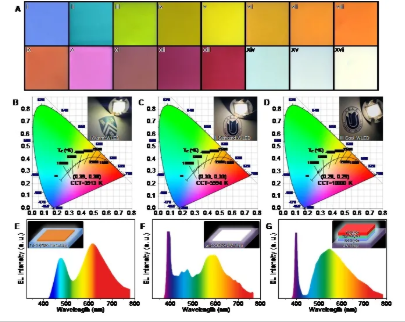Shanghai University Wu Minghong/Wang Liang Deputy
QQ Academic Group: 1092348845
Detailed
Recently, Professor Minghong Wu and Associate Researcher Wang Liang of Shanghai University published a paper entitled "Full-color fluorescent carbon quantum dots" in the comprehensive top journal Science Advances, reporting a high-brightness and high-stability panchromatic fluorescent carbon quantum dots A new preparation method-acid reagents control the electron donating group/electron withdrawing group strategy on the surface of the material, and successfully developed a full-color luminescent film and various types of high color rendering index white light emitting diode (WLED) devices, using this strategy The prepared carbon quantum dots have broad application prospects in the detection of heavy metal ions and pollutants in the environment, photocatalysis and electrocatalysis treatment of refractory organic wastewater in the environment, bioimaging, energy conversion and device storage, and flexible optoelectronic devices.

Fig. 1 Schematic diagram of the acid reagent-regulated synthesis strategy of panchromatic fluorescent carbon quantum dots and their fluorescence photos
WLED is considered to be the first choice for the next generation of lighting equipment due to its advantages of long service life, compact structure and significant energy saving effect. Nowadays, white light is mainly produced by the combination of blue or violet LED chips and multi-color phosphors. Among various phosphor materials, colloidal semiconductor quantum dots have become potential candidates for the development of display and lighting technology. However, the vast majority of semiconductor quantum dots still pose challenges in terms of synthesis and environmental safety, limiting their applications in certain fields.
Carbon quantum dots have emerged as a new type of phosphor for developing WLEDs and are expected to become key components of optoelectronic devices. However, the technical bottleneck encountered is the limitation of emission spectrum and fluorescence color adjustment. Normally, most carbon quantum dots only emit blue, green or yellow fluorescence, and WLEDs based on carbon quantum dots will encounter relatively low color rendering indexes, so it is difficult to implement various types of WLEDs. How to extend the fluorescence of carbon quantum dots to the entire visible light spectrum and be prepared on a large scale, and finally build a multi-type WLED module, has been a hot spot in international research in recent years.
The research team designed a new preparation method-the strategy of acid reagents to regulate the surface of the electron-donating group/electron-withdrawing group, and successfully synthesized a bright and highly stable full-color fluorescent carbon quantum from blue to red and even white. Point system and clarified the quantum size effect. The synthesis strategy relies on the introduction of the electron withdrawing group of the acid reagent during the fusion process. This group continues to grow on the surface of the carbon quantum dots, which makes the emission wavelength redshift and increases its particle size, and finally realizes the carbon quantum dots The perfect combination of high fluorescence quantum yield, optical tunability, excellent stability, etc., to build WLED devices with excellent characteristics, including warm, standard and cool WLEDs.
Figure 2 Application of full-color fluorescent carbon quantum dots in the field of fluorescent composite films and WLEDs

Shanghai University is the first unit and communication unit of the thesis. Associate researcher Wang Liang and PhD student Li Weitao (Class of 2017) in the School of Environmental and Chemical Engineering of Shanghai University are the co-first authors. Professor Wu Minghong and Associate Researcher Wang Liang are the co-corresponding authors. The team of Professor Pulickel M. Ajayan from Rice University provided important suggestions on experimental design and related mechanisms. Professor Zhang Jianhua and Associate Professor Yin Luqiao from the Key Laboratory of New Display Technology and Application Integration of the Ministry of Education of Shanghai University helped the WLED test.
This work was funded and supported by the National Natural Science Foundation of China, the Shanghai Yangfan Scholars Program, the Yangtze River Scholars Program, and the Innovation Team of the Ministry of Education.
Article link:
https://advances.sciencemag.org/content/6/40/eabb6772
Recommended reading
1. Ma Huimin/Shi Wen/Fang Yu "JACS": Ultra-long wavenumber near-infrared two-area probe, helping in vivo, tumor and microvascular imaging 2. "Biomaterials": Self-assembled AIE nanoprobe for multi-scale near-infrared two-area Angiography 3. Fujian Institute of Physics and Architecture "Nano today": New advances in new near-infrared two-zone luminescent quantum dot biomarkers 4. "Advanced Materials": The first design of a near-infrared two-zone photothermal therapeutic agent with 77% high Light-to-heat conversion efficiency 5. Academician Tang Benzhong/Professor Ding Dan "Biomaterials": "Dragonfly-like" near-infrared AIE materials with optimal luminous brightness for precise surgical navigation 6. Suzhou Institute of Nanotechnology Wang Qiangfu/Li Chunyan/Chen Guangcun "JACS" : Advanced near-infrared II zone fluorescence imaging technology and prospects for biomedical applications 7. Song Erqun from Southwest University "AFM": Progress in the analysis of heterogeneous tumor cells based on magnetic gradient separation strategy 8. Song Yujun from Nanjing University "AFM": Develop one Visible light-catalyzed oxidative stress amplifier is used to eliminate complex bacterial infections
Information source: Material Chemistry News
This information is from the Internet for academic exchanges. If there is any infringement, please contact us and delete it immediately
- Previous: Biomaterials: Silicone
- Next: A Rising 2D Star: Nove


 Academic Frontier
Academic Frontier
